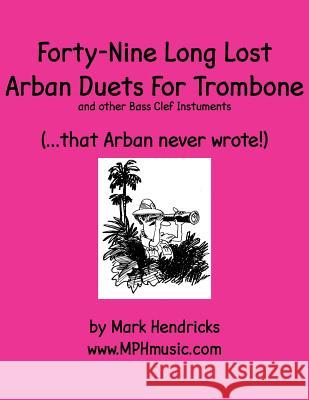Forty-Nine Long Lost Arban Duets For Trombone (...that Arban never wrote!) » książka
Forty-Nine Long Lost Arban Duets For Trombone (...that Arban never wrote!)
ISBN-13: 9781511464987 / Angielski / Miękka / 2015 / 64 str.
Forty-Nine Long Lost Arban Duets For Trombone (...that Arban never wrote!)
ISBN-13: 9781511464987 / Angielski / Miękka / 2015 / 64 str.
(netto: 94,57 VAT: 5%)
Najniższa cena z 30 dni: 99,86
ok. 16-18 dni roboczych
Bez gwarancji dostawy przed świętami
Darmowa dostawa!
The original studies written by J.B. Arban that are the basis for these forty-nine duets are among the most assigned, practiced, played, and reviewed by all brass players - beginner, intermediate, advanced, and pro alike. But there were never duets based on them... until now Practicing and playing them with your friends, students, and colleagues will yield tremendous benefits for all involved. You can even play these with trumpet players, they have their own edition also.
Here's just a few suggestions for using these classic studies as duets:
- Actually schedule a time each week to play duets. We all need to have ensembles to play and perform in, and a duet is the easiest to organize - it's just you and your duet partner. Or add a third player to make things even more fun (plus this makes sure you are resting properly by having only two of you play while the third is resting).
- As you play, be listening closely to yourself and your duet partner to match the attack, tone, phrasing, articulations, dynamics, and intonation to create a truly musical experience. Don't just play notes - always make music
- Be sure to practice and play both parts. Each player will benefit from playing the 1st and 2nd parts. Have the 2nd part player follow the musical example of the 1st part player, then switch parts for more "follow the leader" practice.
- After perfecting duets 19-37 as single tongue duets, speed up the tempo and use double tongue or triple tongue for even more fun.
- These duets are also great for practicing sight reading, transposition, building endurance, increasing range by transposing them into higher keys, and playing rhythmically.
- Practice slowly at first - work for even tone and rhythm, then speed up as you can play cleanly. Always REST as much as you play to avoid overdoing your practicing
Get your copy now and start playing them
Mark Hendricks
MPHmusic.com
Zawartość książki może nie spełniać oczekiwań – reklamacje nie obejmują treści, która mogła nie być redakcyjnie ani merytorycznie opracowana.











